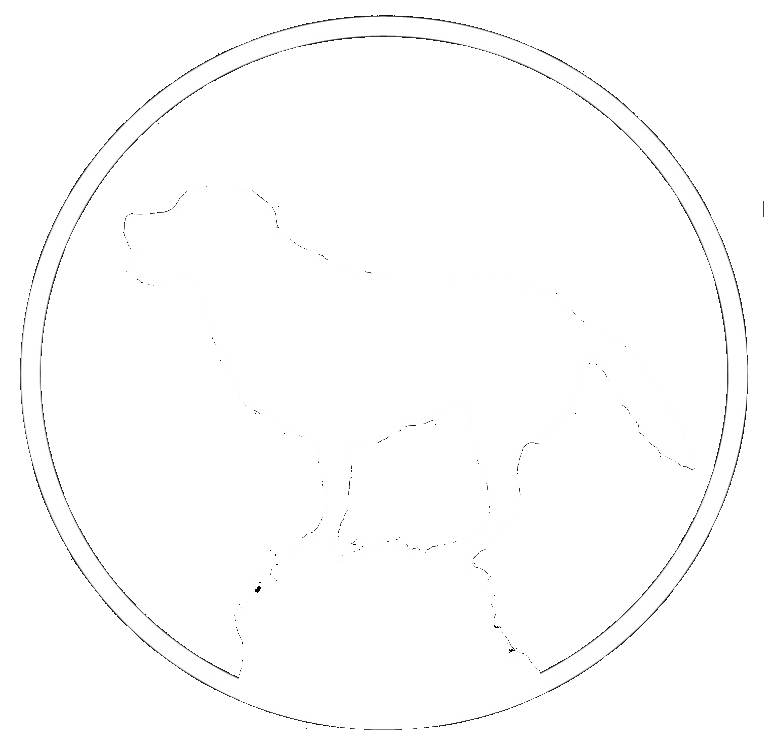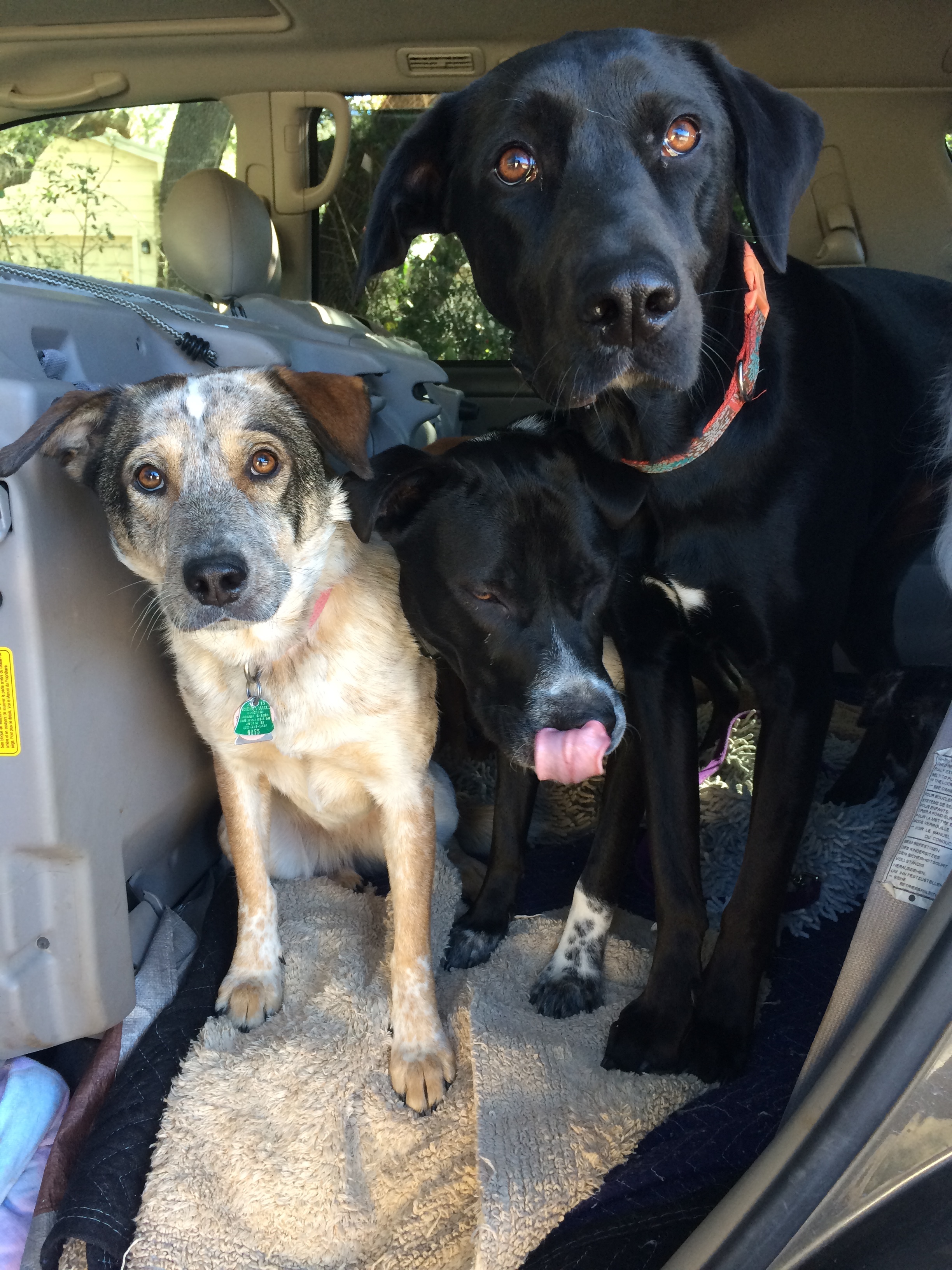If you follow us on social media, you know that our business began by taking a pack of dogs hiking on the trails every day for seven years. In order to keep a group of dogs calm and set the right tone for the hike, we are very deliberate about the way we unload our dogs when we get to the trail. This is just as important for your smaller pack or single dog.
Here is a guide for you to practice at home with your dog.
Dogs in the back: Whether in the backseat or the very back of a hatchback, your dog should always sit in the back of the car. This is for self regulation, and impulse inhibition, as well as safety. Your dog needs to feel safe, be given the job of being calm, and have the self control to not jump up to you in the front seat.
Hooking a leash around a headrest can help teach your dog to stay put while you are driving.
Put yourself first: Part of being a good leader is putting yourself first. When you arrive at your destination, it doesn’t matter how excited they are, your dog needs to wait while you get yourself situated. You don’t want to let an excited dog out of the car and reward that frantic and impatient energy with the reward of launching into a new place.
While you get yourself ready to go, say ‘eh-eh’ if your dog is excited, pacing, whining or barking in the car.
Your dog needs to learn that it is okay to be excited, but those are not okay ways of expressing that excitement.
Opening the Door: Once your dog is calm enough, start to open the door.
You want your dog to wait at the threshold so you can get their leash on
Look around to make sure it’s a good time to exit, and be ready to ask them to sit and wait on a loose leash once they hop out.
Say ‘wait’ as you open the door. If they look like they are about to pounce or if they make any movement towards the door, close it, just enough to make your dog hesitate, and think to themself, “Wow! This door is SO weird! Whenever I move forward, it closes! I wonder if that is related? Jeeze, maybe I’ll try sitting still and see if it opens all the way…”
Don’t Repeat: I don’t like to talk to my dog more than is necessary, but try to keep tabs on your dog and only say “wait” when it looks like the thought of moving forward is starting to cross their mind.
- It’s always easier to correct a thought than an action!
Your dog with my eye contact: You do not want your dog to believe that once you break eye contact they are allowed to break and jump.
- Try to look between your dog and the door instead of at your dog directly.
Don’t block the opening: If you are simply in the way, your dog isn’t doing the work. They are not using self control to hold themself back.
- If that is the case, then the moment you move they will launch out. Instead it’s important to step forward to block when your dog starts to move and try to ease away when you feel your dog is locked in place.
Picking up the Leash: When you have the car door open and feel that your dog understands they are meant to wait, pick up the end of the leash or step forward to put the leash on.
Again, you want your dog to be calm during this process.
If your dog loses composure, start by pulling your hands away or turning away. Making your dog thing to themself:
“When I don’t hold still I don’t get my leash put on! This leash is funny!… Oh no, now they are turning away because I’m too excited! Please, turn back! I’ll settle down!”
This is how we teach our dog what type of energy gets rewarded and what energy moves them further from their goals and desires.
Getting out of the car: Once the leash is on properly and in your hand, step away from the car door, giving your dog room to see if they are staying just because you are in their way. This is a great moment to exercise your dog’s self control muscle and you don’t want to miss out on it.
If they look like they are about to break or if they have that ‘race horse in the starting gate’ energy, sigh, cock your hip to show you are relaxed, and give a little ‘touch’ on the leash.
It isn’t enough to pause, see that your dog’s body is still, then let them launch out.
Pay close attention to their energy.
Hold the space so your dog can do something that we call ‘down-regulating’ which is learning to build the skill of calming themself down. We go from extremely excited, to excited, to alert, to somewhat calm, to fully calm. The goal is to get to the bottom landing of that excitement staircase where your dog sighs and says “gosh, we could be standing here forever!”
That is a great energy and the one to wait for before you reward your dog by exiting the car.
Only calm dogs get the good stuff. Really, calming down isn’t too much of a price to pay for the wonderful experiences you regularly go out of our way to give your dog.
Imagine how different your outing would be if you took a moment at each threshold to wait for your dog to be totally calm?
Waiting when the leash goes on, at the front door, before loading into the car, before unloading from the car, then waiting again on a loose leash after unloading, allows you to close the door and lock your car before you start your walk. It helps to set the tone for a calm walk as well as building a balanced, obedient mindset in general.
The more you ask your dog to be in their thinking brain instead of their impulsive and instinctive brain, the easier it will be for your dog to get to that place in the future.
Contrary to what you may think, this isn’t a waste of ‘exercise’ time.. The mental exertion it takes to engage the thinking brain and hold themself back is exhausting, just like when you have a long, hard day at work and come home tired. Unlike running wild at the park, this exercise is geared towards building the balanced dog you want.
The calmer my dog is, the more tuned in and sensitive they will be. This is where the term ‘dog whisperer’ came from! If you take the time to ask your dog to down regulate, your dog will have the ability to respond to incredibly subtle cues, such as a jingle on the leash, a sound like ‘shhh-shhh,’ a stern glance, or a movement in their direction. It’s amazing!!
Having a picture in your mind of how you want those thresholds to look, holding strong to your boundaries, asking your dog to follow cues to figure out what you are asking for in those exciting moments, and rewarding a calm mindset are all ways that you can shape your dog’s mentality and create the dog you want.
Summary
My dog sits in the back seat
I get ready to go before attending to them
I ask my dog to wait in front of the open car door on a loose leash
I ask my dog to sit and wait after we unload





